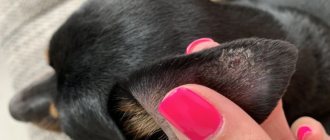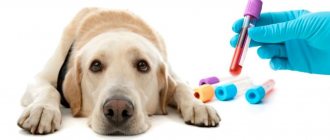What do dog ears normally look like?
The inside of a healthy dog's ear is light pink in color and covered with sparse hairs. A small amount of yellow substance is observed in the external auditory canal - this is a natural secretion, sulfur, which performs a protective, lubricating and cleansing function. There are no other secretions normally. There is no unpleasant smell coming from the ears, they are cool to the touch, without crusts or sores. The skin is not swollen, without redness or peeling.
Injury
Dogs with long floppy ears are often injured. When they are serious, they are noticed by the owner immediately; and minor ones, in which there is no hematoma or bleeding, are usually not detected quickly. They become noticeable only if a translucent yellowish crust forms at the site of minor scratches or cuts.
If it is accidentally torn off, there is almost always no bleeding, and only a clear, slightly yellowish liquid is released. For treatment, simply treat the affected area with an antiseptic. After the wounds heal, the scabs will fall off. For this reason, crusts on the tips of a dog's ears may appear regularly.
Analysis of the reasons for the appearance of crusts on the ears
The disease mainly affects short-haired pets that lead an active life and are exposed to environmental influences.
The most common reasons:
Long-eared pets are most often injured Hunting dogs get into fights with animals, scratch themselves on thorny plants and burrow arches. If dogs live in apartments, they still manage to get injured while walking. Minor abrasions and scratches heal unnoticed by the owner. If a dog accidentally picks off a scab, ichor is released and crusts begin to appear. Treat the defect with any antiseptic spray, which a responsible dog breeder should always have in his first aid kit. If the dog itches, picks off scabs, or bleeds at the tip of the ear, don’t take risks, visit the veterinarian.
Vasculitis is an inflammation of the capillary walls. Experts consider the disease to be an autoimmune disease. Initially, small blood vessels are affected, of which there are many at the tips of the ears. Skin tissues do not receive nutrition and die. The new epidermis does not have time to form, and a wound surface forms. The secreted ichor dries out and crusts form. Pathology has a predisposition to relapse. Characterized by the following symptoms:
- formation of ulcers;
- swelling;
- hair loss;
- touching the ear is painful.
The disease is distinguished by its duration and lack of improvement. If you notice that regular antiseptic sprays or powders do not work, contact a specialist.
Vasculitis
Dermatosis of the edges of dog shells occurs mainly in dachshunds and other dogs with drooping ears. Develops in puppies and old dogs, apparently due to weakened immunity. In most cases, the cause cannot be determined, which is why the dermatosis is called idiopathic. The edges of the shell, covered with scabs, hypertrophy, and with the transition to chronic inflammation, alopecia develops.
The skin cracks and peels off. Sores form, the dog shakes its head. The width of the cracks increases, exudate is released, hardens, crusts form, and the tips of the ears peel off. There are no other symptoms for dermatosis.
Dermatosis of the edge of the ears
Sarcoptic mange is scabies caused by a microscopic mite. Dog breeders confuse the disease with otodectosis, however, the ear mite affects the inner surface of the shell, and Sarcoptes is located on the outside. The arthropod parasitizes the part of the skin rich in nerve endings, so itching is felt immediately after the dog is infected. At the first stage, patches of baldness appear on the face and ears.
If treatment is not started in time, the disease will quickly spread to the entire surface of the body. Areas of hairless skin, ulcers, fistulas, and ulcers form. Therefore, if you notice the signs mentioned above, contact your veterinarian. Ticks can attack humans and cause short-term itching in children and the elderly.
Sarcoptes
Ectoparasites - fleas that pester the dog in the summer; lice and lice-eaters become more active in the winter, when their competitors - fleas - lose activity. The result of arthropod activity is dermatitis. The tips of the ears, fur and skin are affected. Lice and fleas feed on ichor. Lice eaters secrete a sticky secretion, form tangles, inside which they create ideal living conditions.
Attack of flies. The disease develops in summer. It is mainly the chain dogs and dogs guarding the estate that suffer. The diet consists of porridge, as well as category II offal. The feed mixture does not contain vitamins, complete proteins, or omega 3;6 fatty acids. The development of the disease is promoted by heat and dryness. When it dries out and cracks, ichor is released, which attracts burner flies. They eat away at the tips of the ears, causing unbearable suffering to the dog. Most often, symmetrical sores form on shells. If nothing is done, the flies will lay eggs in the skin defects, and the developing larvae will aggravate the suffering.
Microsporia affects the skin, mainly of older dogs with immunity weakened by chronic pathologies. The disease is promoted by keeping the pet in a damp room, as well as prolonged antimicrobial therapy with antibiotics. The fungus affects the hairs, they become thinner, break off and appear as if they have been trimmed. Therefore, the second name for the disease is ringworm . The first foci of alopecia appear on the tips of the ears and muzzle. If you suspect lichen, take your pet to a hospital.
The allergy is characterized by itchy skin rashes. The dog scratches the affected surfaces, they become covered with crusts. Most often, shells react to food irritants.
What to do?
Firstly, it wouldn’t hurt to apply a softening and healing ointment to the ear. For example, Vishnevsky’s balsamic liniment is perfect. Secondly, the affected part of the body must be covered with a bandage and care must be taken so that the animal does not tear it off. If your pet is very active and restless, we strongly recommend using a surgical (aka “Elizabethan”) collar to secure the bandage.
In cases where the wounds fester, the bandage (and ointment, respectively) must be changed daily. If there are no special options, the wound surface can be sprinkled with streptocide powder. In addition, you can use folk treatment by washing the tips of your ears with a strong decoction of calendula and/or chamomile. These plants contain many antiseptic and astringent compounds, so the decoction will promote speedy healing.
Causes of ear pain
Ear diseases in dogs are a fairly common occurrence that occurs as a result of many internal and external factors.
The main cause of inflammation that develops in a dog’s ear is the specificity of their anatomical structure.
The external auditory canal in dogs is not vertical (for example, like in humans), but also has a bend in the shape of the Latin letter L.
Possible causes of ear diseases in dogs may include:
- inflammatory processes as a result of pathogenic microorganisms entering the ear;
- fungal diseases;
- pathologies of viral etiology;
- ectoparasites (ear mites);
- specific reaction to medications;
- allergic problems (food allergies);
- pathologies of the endocrine system;
- autoimmune diseases;
- wounds and scratches;
- abscess.
Each type of ear disease in dogs is characterized by certain symptoms. As a result of various factors, a rough coating may appear on the auricle or a specific pungent odor may arise from the ears.
Vasculitis in dogs
Vasculitis is an inflammation of the inner layer of the vascular wall (endothelium). Vasculitis can also occur as a result of improper self-treatment. Vasculitis in dogs is manifested by the characteristic appearance of scabs and ulcerative lesions in the ear area. The pathology is an inflammatory process of an autoimmune nature, as a result of which the animal’s immunity begins to attack its own healthy cells and tissue structures.
There are several causes of vasculitis - bacterial and viral microorganisms, reactions to specific medications, vaccinations, neoplasia. Symptoms of vasculitis on the ears of dogs are:
- ulcerations on the ear;
- swelling at the site of the lesion;
- febrile conditions in the pet;
- the animal experiences pain when its ears are touched.
Tumor in a dog's ear
Increasingly, in the clinical diagnosis of diseases in dogs, tumors appearing in various parts of the body and internal organs are encountered. A tumor in a dog’s ear occurs against the background of chronic or untreated inflammatory diseases. The neoplasm can be either malignant or benign. In addition, a hematoma in the ear, a growth or an abscess can be mistaken for a tumor.
In the case of a dog's ear hematoma, a specific seal appears, filled with blood as a result of hemorrhages (major or minor), under the skin in the ear. The vast majority of dogs diagnosed with hematomas are long-eared breeds. The main cause of hematoma is mechanical damage. Symptoms of a hematoma include itching, bleeding from the ear, and pain when the animal tries to scratch the ear.
Tumors in the ear also include common tumors - warts and papillomas. The occurrence of pathology is more often found in dogs that do not have a thick coat. The real cause of benign neoplasms is not known. As the papilloma grows, the animal experiences significant discomfort and itching in the ear, but there is no pain.
An abscess that occurs under the influence of pathogenic bacterial microflora can be diagnosed as a tumor with purulent contents. A fairly common cause of abscesses in a dog's ear is insect bites or mechanical damage. When an abscess occurs in an animal, the body temperature rises, and severe pain appears in the area of suppuration.
Note! When a purulent sac ruptures into the inner ear, infection of the internal parts of the ear canal is possible, as well as infection of the adjacent membranes of the brain.
Otitis
The inflammatory process that occurs as a result of insect bites, formed sulfur plugs, or due to an allergy to medications is called otitis media. The main reason is the penetration of pathogenic microorganisms - fungi and bacteria - into the affected area of the skin. Depending on the location of the lesion, otitis is divided into external, middle and internal.
With external otitis, the pathological process affects the area of the ear between the opening of the ear canal and the eardrum. Otitis media affects the area located behind the eardrum, and internal otitis leads to inflammation of the labyrinths of the ear canal. When otitis occurs, the following symptoms are characteristic:
- frequent shaking of the head (tilting one way or the other);
- loss of appetite;
- on palpation the ear is very hot;
- purulent discharge from the ear stinks;
- bloody discharge;
- hyperemia of the inner part of the ear and swelling.
It is worth remembering that otitis in dogs is dangerous, since if not treated in a timely manner, the disease becomes chronic. The released pus can get inside the ear, causing inflammation of the membranes of the brain, or if pathogenic microflora penetrates the systemic bloodstream, it can cause infection in the pet’s blood. In both cases, death is possible.
Fungal diseases
Fungal infection in dogs' ears is a common occurrence encountered in clinical veterinary practice. The disease takes a long time to be treated and is quite problematic, but the likelihood of an absolute recovery is not always predicted.
In the vast majority of dogs, fungal microorganisms belonging to the genus Malasezia and Candida are found. Fungal non-pathogenic microflora is always present in the body of animals. But in the event of a decrease in the body’s immune forces, due to poor nutrition, hypothermia and other factors, Malasesia begins to actively reproduce, causing serious pathological changes.
With regards to candidiasis affecting the ear, in this case everything is almost identical - yeast fungi inhabit the pet’s coat without showing themselves for a long time. When immunity decreases, characteristic symptoms of damage occur.
The main symptoms of fungal ear infection are:
- itching sensation;
- there is an unpleasant smell from the ear canal area;
- the pet becomes restless.
Against the background of irritation of the ear canal by the development of fungal microflora, the pet may refuse to eat, constantly tearing its ears with its paws until they bleed. In this case, the inflammatory process, on the contrary, begins to intensify. Scabs form in the dog’s ears with crusts of dried blood. The appearance of a characteristic fetid odor is also important - an invariable companion of yeast lesions in the ears of an animal.
Ear mite
One of the most common causes of odor and sores on the ears of dogs is ear mites. The parasite is capable of infecting both street dogs and pets living exclusively in apartment conditions. A microscopic parasite settles in the ears of an animal, multiplying with ease, since the dog’s coat creates an excellent microclimate and protection for its life. It is not possible to notice ear mites without special research.
The appearance of ear mites can occur regardless of the age of the pet. But most often puppies and young animals suffer from this parasite. This is due to the immaturity of the pets’ body’s defenses. The main symptoms of ear mite infestation are:
- increased production of earwax;
- thick and dark discharge from the ear;
- itching and scratched ears;
- sores appear on the tips of the dog’s ears.
The tick is able to parasitize in the dog’s ear canal for quite a long time, feeding on dead and keratinized cells, as well as tissue fluids. If not detected and treated in a timely manner, the mite can migrate under the skin, spreading throughout the body. In this case, the animal becomes even more restless, constantly trying to thoroughly scratch its back, neck or tail.
Dermatitis
If your dog has crusts on the tips of his ears, this could be the cause of dermatitis. At the same time, the disease affects not only the ears, and is usually accompanied by the appearance of small ulcers and peeling on other parts of the body.
If the disease process is not advanced, then special ointments will help cope with dermatitis.
Lichen
The lesion can occur on any part of the body, including the ears. Most lichens are contagious to humans. With the disease, not only the appearance of crusts is observed, but also cracks and ulcers. The hair on the affected area falls out. Because of the itching, the dog vigorously rubs the affected ear with its paw, which in most cases spreads the disease to it.
Consequences of ear injury
Ear injuries in dogs are not uncommon. They are often damaged in a fight; animals can cling to thorny bushes or sharp objects with them. Due to the close proximity of the capillaries, bleeding begins at the slightest damage.
The damaged ear is washed with warm water and gauze is applied to absorb the blood. The wound is sealed with a plaster, the ear is bandaged, pressing it to the head. The dog is taken to the veterinarian to evaluate the condition, exclude internal injuries, and apply stitches (if necessary).
The consequence of an injury can be a hematoma - an accumulation of blood and lymph between the cartilage and skin of the ear, which swells, hurts, and its inside becomes red. Body temperature rises. The pet tilts its head towards the sore ear and is often tormented by severe itching. A hematoma is treated in the clinic - the fluid is pumped out and procedures are performed. Sometimes surgery is required - the tissue is cut, the damaged vessel is blocked.
Allergy
Allergies often cause dry crusts to appear all over the animal’s body, including the tips of the ears. With this phenomenon, the pet constantly itches and bites itself until it bleeds, and it begins to secrete large amounts of tear fluid and wax secretion from the ears. General swelling is also possible. In severe cases, signs of allergy include drooling and loss of coordination. For emergency help at home, you can use suprastin. The dosage is calculated based on the weight of the animal.
Crusts on the tips of a dog’s ears are rarely a signal of a dangerous disease that threatens the animal’s life, but they cannot be considered the norm. To restore your pet’s health, therapy must be timely.
Skin allergic reaction
Allergies are one of the most common causes of ear problems in dogs. An acute immune response to an irritant leads to the development of allergic otitis media. The ears “flow”, swell, turn red, and itch. When scratching, an infection often occurs. Allergic diseases also include atopic dermatitis. Dark viscous discharge appears in the ears, sometimes foul-smelling, the skin peels and becomes covered with scabs.
Treatment of allergies consists of avoiding contact with the irritant, taking antihistamines, glucocorticosteroids, and using ear drops (Otipax, Sofradex) to relieve discomfort.
The cause of the allergy may be:
- food (chicken, duck, egg yolk, milk, sweets, nuts, food additives);
- cosmetics for dogs;
- medicines;
- household chemicals;
- plant pollen.
Demodicosis of the external ear
Demodicosis of the external ear
The causative agent of the disease is the microscopic parasite glandular. It lives in the sebaceous glands and hair follicles of most dogs and is usually not dangerous, but under unfavorable factors (decreased immunity, hormonal imbalances, stress, some diseases) it begins to actively reproduce.
The mite can be localized on the ears, penetrating into the deep layers of the skin. Its waste products cause irritation, redness and itching, and the inner surface is covered with scales. Scratching appears, hair falls out, and sulfur accumulates in the passages. The ears are hot and painful.
To increase immunity, vitamin-mineral complexes are used, and antiparasitic drugs (Ivermectin, Milbemycin, Avarsect) are used to destroy the pathogen.
Amit drops and aversectin ointment are effective against demodex. Damaged skin is treated with Levomekol or Ichthyol ointment, which have antiseptic, analgesic and anti-inflammatory properties.
Otodectosis (ear mites)
More often, the disease occurs in indoor dogs that come into contact with cats that have free access to the street; or those living on the street and in contact with stray animals. Pedigree pets have less strong immunity and therefore are more often affected by ticks than purebred dogs.
An ear mite is a microparasite that, penetrating the ear, penetrates the upper layer of skin and feeds on its keratinized particles. Its waste products cause itching and inflammation in the animal. If the inflammatory process is sluggish, then the crusts at the end of the ear appear first. When there is no treatment, inflammation progresses and parasites multiply. Because of this, suppuration develops, which only worsens the dog’s condition.
Additional symptoms of otodectosis are the following: unpleasant odor from the ear, severe itching and accumulation of a black-brown mass (mite waste) in the ear canals. Treatment of the disease includes the following steps:
- cleaning the ears with a cotton swab soaked in hydrogen peroxide;
- instillation of special drops against ear mites;
- treating crusts with chlorhexidine or brilliant green to prevent infection.
If the disease is not treated, then inflammation gradually develops, which spreads to the brain and leads to the death of the pet.
To speed up your pet's recovery, it is necessary to increase the duration of walks and provide the most balanced diet.
Diagnostics
In order to prescribe adequate treatment for ear disease in dogs, a veterinarian must conduct a diagnosis. Excluding ear diseases caused by parasites requires special microscopic examination of pathological material. Ear mites are caused not only by otodectosis, but also by other types of subcutaneous mites (for example, demodicosis).
It is imperative to conduct bacteriological studies necessary to determine the causative agent of bacterial origin and prescribe the correct antibiotic.
Also, dogs with suspected internal otitis undergo an x-ray examination to detect the accumulation of pathological exudate and destruction of bone tissue.
Lichen
The most dangerous disease. And we are talking here not only about the pet, but also about its owner, since a person can also become infected.
The onset of the disease can be determined by rapidly manifesting signs:
- Constant itching of the affected areas . At the same time, in trying to scratch itself, the dog spreads the infection to an increasingly larger area of its own body.
- Baldness of damaged areas.
- Crusts appear , which then change into cracks and ulcers that release blood.
If even the first symptoms appear, it is necessary to immediately isolate the pet from other residents of the house and take it to a veterinary clinic for examination and treatment.
Treatment of ear sores in dogs
Ear diseases in dogs require a comprehensive approach and treatment. In case of severe disturbances in the coordination of movements with obvious signs of pathological conditions of the vestibular apparatus, animals are hospitalized and immediate treatment is begun in a hospital setting.
The use of antimicrobial agents for ear diseases in dogs is necessary in cases where the eardrum is ruptured or when there is a heavy contamination with staphylococci or streptococci.
Therapy for dogs consists of the following points:
- treatment of the ears with special solutions (if the eardrum is perforated, only saline solution can be used);
- the use of sulfur-thinning substances - peroxide, dioctyl;
- antimicrobial agents (sulfonamides, Trichopolum, Enrofloxacin);
- antifungal agents.
- prescribing a special diet (to eliminate allergic reactions).
If ear sores of uncomplicated etiology appear in dogs, you can treat the animal at home. For this purpose, local and general treatment is used. So, for tumors (hematomas or abscesses in the ear), it is necessary to conceal and remove blood clots and pus. Subsequently, the affected area is treated with antiseptic solutions.
Vasculitis
In the case of this disease, in addition to the formation of crusts at the end of the ear, the dog also experiences hair loss in the affected area. Also, in most cases, intense redness appears over most of the inner side of the ear.
Vasculitis is an inflammation of the walls of blood vessels that develops due to an improper immune response of the body to its own tissues. The ears are the first to be affected. The disease cannot be called common, but it can occur in animals of any age. Crusts on the tips of a dog's ears when the disease occurs are formed due to the fact that the walls of the blood vessels are damaged and numerous small wounds appear, which are quickly covered with a crust, usually brown in color.
Treatment of vasculitis is complex. For some animals it is a course, after which the problem is completely eliminated; and for others, lifelong therapy is required. You should also take into account the fact that the disease can recur after the outbreak is eliminated. Because of this, the condition of a dog that has encountered vasculitis requires constant monitoring.
Prevention
Ear diseases in dogs can be prevented if you follow certain rules, including personal hygiene, proper nutrition, keeping your pet, and regular preventive examinations with a veterinarian.
Owners of dogs with long ears should be especially careful. These pets need extra care and attention to their ears. When the slightest symptoms appear in an animal - itching in the ears, restlessness, strange turns of the head in one direction or the other, signal the presence of pathologies in the ears. If sores, crusts on the ears, or an unpleasant odor appear, you should immediately contact a qualified doctor.
Why does my skin peel?
The skin is an integral organ of the immune system, which consists of many elements: epithelium, endothelium, hair, sebaceous glands . Their joint work regulates the body’s defense functions, and disruption of at least one component results in a general loss of immunity and frequent illnesses.
Causes of lesions inside the ear
- Seborrhea (dandruff) caused by nutritional imbalance, pests (check your ears, there may be mites there).
- Thermal or mechanical injuries. If your dog has damaged the area of skin behind the ear, it will peel as it heals.
- Disruption of the sebaceous glands. When they produce too little sebum, the skin becomes dry and flaky.
- Allergic reactions to medications or food.
But why the skin suffers only on the ears is a separate question. If the rest of the body is healthy and unharmed, then the ears are a place weakened by certain factors . This can be either inflammation or pathogens.
Red or dirty
Inspect your ears for dirt; it is quite possible that the dirt that came from the street contained toxins or toxic substances .
If there is plaque on the ears, redness, unpleasant odor, swelling, this indicates the presence of a disease that needs to be diagnosed. REFERENCE! During the period of sexual heat, some breeds are subject to changes in the body to attract a partner. Thus, the glands that secrete enzymes work in overdrive, which causes the release of secretions onto the skin, which exfoliates in response.











